Mission Support Crew 202 Operations Report 01Jan2019
Mission Support Crew 202 Greenhab Report 31Dec2018
Crew Photos Dec 31st
Journalist Report Dec 31st
MDRS Crew 202, Journalist Report
Sol 2 – 12/31/2018
Name the space movie given the following quote. Answer at the end of the Report:
Now, this is important. Once the battery is removed, everything is gonna slam into emergency mode. Once we have it, we gotta move quickly, so you definitely need to get that last… Or we could just get it first and improvise!
—
Today’s the day! The snow is falling! And we are officially starting the Sim! The sun rose with the symphonic sounds of the Apollo 13 soundtrack echoing through the habitat. It may be the last day of the year, but it is the first day of real Mars living for our crew. Through the white noise of the water pump, crew “singing” (a.k.a. snoring), and the occasional bumps in the night of members discovering different walls and corners surrounding their bed, the crew awoke refreshed and ready. Sleep was especially important last night. Today, the entire crew would perform their first Extra-Vehicular Activities (EVAs).
The day began with sweeping and shoveling of snow on the porches, tunnels, and solar arrays of our home. This proved fruitless as it snowed again in the afternoon, but at least we were safe from ice for the first few hours. This was followed by our last MDRS training session on how to drive the rovers. Now the real work begins, but what does a “full simulation” entail? Full simulation includes limited communication with the outside world, standing in an air lock for 5 minutes to depressurize the entryway when exiting the habitat, and donning our suits anytime we leave the safety of the habitat. Essentially, it’s continually asking the question “Is this something that would be done on Mars?”.
The EVAs were a wonderful learning opportunity as we explored the capabilities of the rovers and tested the comfort of the suits. Flurries melted onto our helmets as we traversed the “Marble Ritual” landscape. Each member danced among the painted, hanging bunt pans, miraculously not hitting any of the poles with our limited vision in the clunky space suits. We found a rock with holes that looked like a smiley face, crunched over clay and dirt to test the GoPros on the expansive mountain landscape, and quickly returned to the warmth and comfort of the habitat. The crew is as green as can be with only one veteran Martian on board, but we are also excited, hard-working, and determined to make the most of our time on Mars as we learn the ins and outs of performing an EVA.
If you thought the Great Nutella Crisis of Crew 202 was traumatic, you haven’t heard of the even GREATER Tea Kettle Crisis of Crew 202. Today the tea kettle broke… leaving us to boil water on the stove like pilgrims. It’s a true tragedy here on Mars, but I think the crew will power through it.
An exciting end to an exciting day as the crew prepares to celebrate New Years Eve on the Red Planet. The commander is cooking baked ziti which intoxicates the room with smells of tomato, basil, and garlic. It is almost as powerful as the aroma of chocolate brownies by our Crew Engineer emanating from the toaster oven. As we prepare the 2019 tiaras, blow on the noise makers, and pull the tab on poppers, we reflect on the previous year and the new year to come. The meetings, preparations, and packing that has brought us to this moment as a new crew family, and the incredible adventure that awaits us in the new year. When midnight on Earth strikes at 0.5317 Martian years, we will hold our loved ones on the pale blue dot in our thoughts and wish everyone back on our first home a Happy New Year.
—
Movie Answer: Guardians of the Galaxy
EVA Report Dec 31st
Crew 202 EVA Report 31-Dec-2018
EVA #2
Author: Denys Bulikhov (EXO)
Purpose of EVA: familiarization with suits, rovers, communication procedures, testing the ability to use scientific equipment in EVA conditions.
Start time: 15:36
End time: 16:23
Narrative: EVA 2 crew successfully reached the Marble Ritual. On site EXO attempted to use some of the scientific equipment. It was partially successful due to freezing wind and blizzard. Familiarization had to be cut short due to deteriorating Martian weather.
Destination: Marble Ritual
Coordinates (use UTM NAD27 CONUS): E518700, N4250800
Participants: Denys Bulikhov (EXO), Kasey Hilton (ENG), Jake Qiu (HSO)
Road(s) and routes per MDRS Map: Cow Dung Road, then walk East towards Marble Ritual
Mode of travel: Driving and walking
Vehicles used: Spirit and Opportunity
With best regards,
Denys Bulikhov
Green Hab Report Dec 31st
Crew 201 Greenhab Report 31-DEC-2018
Greenhab Officer:
Jake Qiu
Environmental Control:
Heating
Cooling w/ ambient air (1hrs)
40% Shade Cloth on
80% Shade Cloth put on far right corner
Average Temperatures:
Low: 22.9°C
High: 33.0°C
Hours of Supplemental Light:
5
Daily Water Usage of Crops:
8 gallons
Water in Blue Tank (lbs):
95%
Times of Watering for Crops:
1708
Changes to crops:
* Mixed salad greens harvested
* Cucumbers displaying good progress
* Chives sprouting
* Radish displaying good progress
* Carrots look dry
* Cress displaying good growth
* Sugar Snow Peas displaying good growth
* Savory Mix sprouting
Narrative:
Its about to be 2019 and we are celebrating with a large meal!
Fortunately, the greenhouse can provide with some herbs and mixed greens for the feast!
Some plants were harvested and watered. A majority of the plants are looking good.
Some of the carrots’ stem are not rigid and falling over.
Experiment Results:
Date: SOL2 Crew 202 (SOL14 overall)
Watered samples
Harvest:
* Basil – 6 g
* Parsley – 1 g
* Mixed Salad Greens – 259 g
Support/Supplies Needed:
Best,
Jake
Operations Report Dec 31st
Crew 202 Operations Report 31-DEC-2018
SOL: 2
Name of person filing report: Kasey Hilton
Non-nominal systems: Suits #3 & #7, electric tea kettle, and hot water heater
Notes on non-nominal systems: Two-piece suit #3 and one-piece suit #7 won’t turn on even when plugged in; Electric tea kettle in kitchen does not turn on even when we plugged it into a different outlet; Hot water heater ignitor doesn’t work so there is not hot water in the Hab.
Generator (hours run): 7hr 47min; Turned off around 9:38 AM; Turned on at 5:25 PM
Solar – SOC 86%
Diesel Reading – 75%
Propane Reading – 57%
Ethanol Free Gasoline – Not in use
Water (auxiliary tank) – Not in use
Water (static tank) – Full; 530 gallons
Auxiliary to Static tank transfer – No
Gallons transferred: Not applicable
Water in GreenHab – Full; 280 gallons (assuming that the tank is 300 gallons)
Water (loft) – At level marker 12
Static to Loft Pump used – Yes; At 6:24 PM to refill loft tank
Water Meter: 01397146 units
Toilet tank emptied: No
Deimos rover used: No, still not functional
Hours: Not applicable
Beginning charge: Not applicable
Ending charge: Not applicable
Currently charging: Not applicable
Sojourner rover used: ASSIGNED TO DIRECTOR
Hours: Not applicable
Beginning charge: Not applicable
Ending charge: Not applicable
Currently charging: Not applicable
Spirit rover used: Yes
Hours: 63.4
Beginning charge: 84%
Ending charge: 74%
Currently charging: Yes
Opportunity rover used: Yes
Hours: 45.2
Beginning charge: 90%
Ending charge: 83%
Currently charging: Yes
Curiosity rover used: Yes
Hours: 61.5
Beginning charge: 100%
Ending charge: 74%
Currently charging: Yes
Notes on rovers: None
ATV’s Used: Honda, YODA (300), 350.1 (Honda, 300, 350.1, 350.2, 350.3)
Reason for use: Training for geology EVA
Oil Added? No
ATV Fuel Used: Tanks are still full; Only used for about 10 minutes each
# Hours the ATVs were Used today: 1hr
Notes on ATVs: All VIN numbers on ATVs were located and registration papers were found for one. YODA, Honda, and two of the 350s were started and driven today, but they were very hard to start in the cold. The Honda, YODA, and 350.1 remain at the Hab for a geology EVA later in the rotation. There are two other 350s that are being worked on since one battery doesn’t work and the other is making a weird noise. One of these 350s will be brought to the Hab later.
HabCar used and why, where? Off site
CrewCar used and why, where? Off site
General notes and comments: Spent the first half of the day training for EVAs and ATVs. The second half of the day was spend doing two EVAs, both to Marble Ritual and back.
Summary of internet: Nothing to report
Summary of suits and radios: Two-piece suit #3 and one piece suit #7 air flow not working as reported from yesterday and mentioned above in “Non-nominal systems”
Summary of Hab operations: The hot water heater igniter doesn’t work and there is not hot water in the Hab as mentioned above in “Non-nominal systems”
Summary of GreenHab operations: Nothing to report
Summary of ScienceDome operations: Nothing to report
Summary of RAMM operations: Nothing to report
Summary of any observatory issues: Nothing to report
Summary of health and safety issues: Nothing to report
Questions, concerns and requests to Mission Support: I have not heard anything about the two-piece suit #3 since it was reported about 2 days ago.
Sol Summary Report Dec 31st
Crew 202 Sol Summary Report / Commander Report 31-Dec-2018
Sol: 2
Summary Title: So it begins..
Author’s name: Cesare Guariniello
Mission Status: The crew is now in full simulation. We are on Mars, though it looks like we landed somewhere close to the polar cap!
Sol Activity Summary: What an exciting day here! We woke up to an unexpected 2 inches of fresh snow, in a winter wonderland. Since we still had to complete our training with Rover driving and EVA suits training, we were not in simulation yet, so we could sweep and shovel the tunnels, the front porch, and the solar panels without wearing suits. The Rover training got all of us slightly cold, so we decided to get back in the habitat and enjoy some hot chicken noodle soup before completing the training. In the afternoon, we finally celebrated the beginning of our simulation, which started immediately with two short EVAs that gave every crew member a chance to experience how driving and hiking in a heavy suit feels.
What a great feeling for me to be back into my space suit. I am also lucky because the two-piece suit fits me perfectly! But the top for me today was to look at my crew mates during the airlock pressurization, and outside in the field: in their eyes and their enthusiasm I saw a reflection not only of me last year, during my first experience in EVA, but also the same joy that I feel this year. It is good to be here, and it is great to see a completely different face of Mars, an icy and snowy face. But the cold did not stop us, each member of the crew has aspirations to go to space or to help our effort to reach Mars, and some discomfort is a small price to pay in exchange for being a part of this!
Look Ahead Plan: Due to the large amount of snow, we will not attempt any EVA tomorrow (except for engineering EVA to keep our front porch clean of snow), and we will spend an amazing New Year’s Day getting to explore our home for the next two weeks. We will start a few outreach and crew conditioning projects, and enjoy the day on Mars!
Anomalies in work: None
Weather: cold, with some snow precipitation during the day
Crew Physical Status: In perfect health, and all EVA-tested
EVA: Two short EVAs to Marble Ritual, to get the crew used to EVA protocols, communication protocols, and the joys and pains of activity in a space suit.
Reports to be filed: Sol Summary, Operations Report, Greenhab Report, Two EVA Reports, Journalist Report
Support Requested: None
Cesare
Commander, MDRS 202
EVA Report Dec 31st
Crew 202 EVA Report 31-DEC-2018
EVA #1
Author: Ellen Czaplinski
Purpose of EVA: To familiarize the crew with the flight suits, rovers, and COMMS
Start time: 3:36 pm
End time: 4:23 pm
Narrative: Crew 202’s very first EVA on Mars was to the Marble Ritual,
an area within view of the Hab with some ancient marble structures at
the entrance. We did the dance ritual at the marbles, which consisted
of the YMCA, the MARS, and flossing. However, the EVA suits restricted
movement quite a bit. A light dusting of snow was falling throughout
the duration of the EVA. We investigated the clays and interesting
rocks in the area, although difficult with all the fresh snow on the
ground. After riding the ATVs and walking around with the EVA suits
on, we noticed a few areas on the suits that needed to be adjusted, so
we will look into that tomorrow.
Destination: Marble Ritual
Coordinates (use UTM NAD27 CONUS): E518700, N4250800
Participants: Cesare Guariniello (CMDR), Ellen Czaplinski (GEO),
Alexandra Dukes (JOU)
Road(s) and routes per MDRS Map: Cow Dung Road, then walk East towards
Marble Ritual
Mode of travel: Driving ATVs and walking


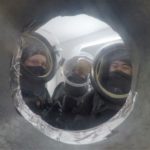
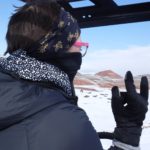
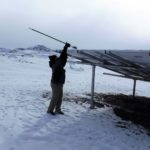
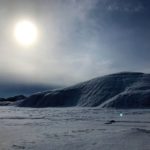
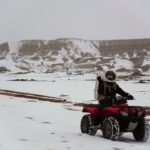
You must be logged in to post a comment.